Nonlinear Optical Microscopy and Plasmon Enhancement
Abstract
:1. Introduction
2. Nonlinear Optics Effect Process of Surface Plasmon
3. Surface Plasmon Resonances Enhanced the Nonlinear Optics Microscopy
3.1. Nonlinear Optical Enhancement in Surface Plasmons of Metal Nanoparticles
3.2. The Application of Nonlinear Optical Microscopy System
4. Summary
5. Outlook
Funding
Institutional Review Board Statement
Informed Consent Statement
Data Availability Statement
Conflicts of Interest
References
- Kang, D.; Li, R.; Cao, S.; Sun, M. Nonlinear optical microscopies: Physical principle and applications. Appl. Spectrosc. Rev. 2021, 56, 52–66. [Google Scholar] [CrossRef]
- Ahmadivand, A.; Gerislioglu, B. Deep-and vacuum-ultraviolet metaphotonic light sources. Mater. Today 2021, 51, 208–221. [Google Scholar] [CrossRef]
- Shen, W.; Chen, J.; Wu, J.; Li, X.; Zeng, H. Nonlinear optics in lead halide perovskites: Mechanisms and applications. ACS Photonics 2020, 8, 113–124. [Google Scholar] [CrossRef]
- Autere, A.; Jussila, H.; Dai, Y.; Wang, Y.; Lipsanen, H.; Sun, Z. Nonlinear optics with 2D layered materials. Adv. Mater. 2018, 30, 1705963. [Google Scholar] [CrossRef] [Green Version]
- Schawlow, A.L.; Townes, C.H. Infrared and optical masers. Phys. Rev. 1958, 112, 1940. [Google Scholar] [CrossRef] [Green Version]
- Kleinman, D. Nonlinear dielectric polarization in optical media. Phys. Rev. 1962, 126, 1977. [Google Scholar] [CrossRef]
- Franken, P.; Ward, J. Optical harmonics and nonlinear phenomena. Rev. Mod. Phys. 1963, 35, 23. [Google Scholar] [CrossRef]
- Heiman, D.; Hellwarth, R.; Levenson, M.; Martin, G. Raman-induced Kerr effect. Phys. Rev. Lett. 1976, 36, 189. [Google Scholar] [CrossRef]
- Hellwarth, R. Third-order optical susceptibilities of liquids and solids. Prog. Quantum Electron. 1977, 5, 1–68. [Google Scholar] [CrossRef]
- Shen, Y. Recent advances in nonlinear optics. Rev. Mod. Phys. 1976, 48, 1. [Google Scholar] [CrossRef] [Green Version]
- Parodi, V.; Jacchetti, E.; Osellame, R.; Cerullo, G.; Polli, D.; Raimondi, M.T. Nonlinear optical microscopy: From fundamentals to applications in live bioimaging. Front. Bioeng. Biotechnol. 2020, 8, 585363. [Google Scholar] [CrossRef] [PubMed]
- Li, R.; Wang, X.; Zhou, Y.; Zong, H.; Chen, M.; Sun, M. Advances in nonlinear optical microscopy for biophotonics. J. Nanophotonics 2018, 12, 033007. [Google Scholar] [CrossRef]
- Kauranen, M.; Zayats, A.V. Nonlinear plasmonics. Nat. Photonics 2012, 6, 737–748. [Google Scholar] [CrossRef]
- Dudley, J.M. Light, lasers, and the Nobel Prize. Adv. Photonics 2020, 2, 050501. [Google Scholar] [CrossRef]
- Zhao, J.; Xue, S.; Ji, R.; Li, B.; Li, J. Localized surface plasmon resonance for enhanced electrocatalysis. Chem. Soc. Rev. 2021, 50, 12070–12097. [Google Scholar] [CrossRef]
- Prabowo, B.A.; Purwidyantri, A.; Liu, K.-C. Surface plasmon resonance optical sensor: A review on light source technology. Biosensors 2018, 8, 80. [Google Scholar] [CrossRef] [Green Version]
- Zhao, X.; Hao, Q.; Ni, Z.-H.; Qiu, T. Single-molecule surface-enhanced Raman spectroscopy (SM-SERS): Characteristics and analysis. Acta Phys. Sin. 2021, 70, 137401. [Google Scholar] [CrossRef]
- Li, C.; Le, V.; Wang, X.; Hao, X.; Liu, X.; Kuang, C. Resolution Enhancement and Background Suppression in Optical Super-Resolution Imaging for Biological Applications. Laser Photonics Rev. 2021, 15, 1900084. [Google Scholar] [CrossRef]
- Zhang, C.; Hugonin, J.-P.; Greffet, J.-J.; Sauvan, C. Surface plasmon polaritons emission with nanopatch antennas: Enhancement by means of mode hybridization. ACS Photonics 2019, 6, 2788–2796. [Google Scholar] [CrossRef]
- Kuo, C.-F.; Chu, S.-C. Dynamic control of the interference pattern of surface plasmon polaritons and its application to particle manipulation. Opt. Express 2018, 26, 19123–19136. [Google Scholar] [CrossRef]
- Butet, J.; Brevet, P.-F.; Martin, O.J. Optical second harmonic generation in plasmonic nanostructures: From fundamental principles to advanced applications. ACS Nano 2015, 9, 10545–10562. [Google Scholar] [CrossRef] [PubMed]
- Ahmadivand, A.; Semmlinger, M.; Dong, L.; Gerislioglu, B.; Nordlander, P.; Halas, N.J. Toroidal dipole-enhanced third harmonic generation of deep ultraviolet light using plasmonic meta-atoms. Nano Lett. 2018, 19, 605–611. [Google Scholar] [CrossRef] [PubMed]
- Azzouz, A.; Hejji, L.; Kim, K.-H.; Kukkar, D.; Souhail, B.; Bhardwaj, N.; Brown, R.J.; Zhang, W. Advances in surface plasmon resonance–based biosensor technologies for cancer biomarker detection. Biosens. Bioelectron. 2022, 197, 113767. [Google Scholar] [CrossRef] [PubMed]
- Wang, Q.; Ren, Z.-H.; Zhao, W.-M.; Wang, L.; Yan, X.; Zhu, A.-S.; Qiu, F.-M.; Zhang, K.-K. Research advances on surface plasmon resonance biosensors. Nanoscale 2022, 14, 564–591. [Google Scholar] [CrossRef] [PubMed]
- Zong, C.; Xu, M.; Xu, L.-J.; Wei, T.; Ma, X.; Zheng, X.-S.; Hu, R.; Ren, B. Surface-enhanced Raman spectroscopy for bioanalysis: Reliability and challenges. Chem. Rev. 2018, 118, 4946–4980. [Google Scholar] [CrossRef]
- Willets, K.A.; Van Duyne, R.P. Localized surface plasmon resonance spectroscopy and sensing. Annu. Rev. Phys. Chem. 2007, 58, 267–297. [Google Scholar] [CrossRef] [Green Version]
- Ma, S.; Yang, D.-J.; Ding, S.-J.; Liu, J.; Wang, W.; Wu, Z.-Y.; Liu, X.-D.; Zhou, L.; Wang, Q.-Q. Tunable size dependence of quantum plasmon of charged gold nanoparticles. Phys. Rev. Lett. 2021, 126, 173902. [Google Scholar] [CrossRef] [PubMed]
- Wang, X.; Liu, C.; Gao, C.; Yao, K.; Masouleh, S.S.M.; Berté, R.; Ren, H.; Menezes, L.d.S.; Cortés, E.; Bicket, I.C. Self-constructed multiple plasmonic hotspots on an individual fractal to amplify broadband hot electron generation. ACS Nano 2021, 15, 10553–10564. [Google Scholar] [CrossRef]
- Shi, J.; Guo, Q.; Shi, Z.; Zhang, S.; Xu, H. Nonlinear nanophotonics based on surface plasmon polaritons. Appl. Phys. Lett. 2021, 119, 130501. [Google Scholar] [CrossRef]
- Törmä, P.; Barnes, W.L. Strong coupling between surface plasmon polaritons and emitters: A review. Rep. Prog. Phys. 2014, 78, 013901. [Google Scholar] [CrossRef]
- Joseph, S.; Sarkar, S.; Joseph, J. Grating-Coupled Surface Plasmon-Polariton Sensing at a Flat Metal–Analyte Interface in a Hybrid-Configuration. ACS Appl. Mater. Interfaces 2020, 12, 46519–46529. [Google Scholar] [CrossRef] [PubMed]
- You, J.; Bongu, S.; Bao, Q.; Panoiu, N. Nonlinear optical properties and applications of 2D materials: Theoretical and experimental aspects. Nanophotonics 2019, 8, 63–97. [Google Scholar] [CrossRef]
- Dorfman, K.E.; Schlawin, F.; Mukamel, S. Nonlinear optical signals and spectroscopy with quantum light. Rev. Mod. Phys. 2016, 88, 045008. [Google Scholar] [CrossRef] [Green Version]
- Edappadikkunnummal, S.; Nherakkayyil, S.N.; Kuttippurath, V.; Chalil, D.M.; Desai, N.R.; Keloth, C. Surface plasmon assisted enhancement in the nonlinear optical properties of phenothiazine by gold nanoparticle. J. Phys. Chem. C 2017, 121, 26976–26986. [Google Scholar] [CrossRef]
- Prabu, S.; David, E.; Viswanathan, T.; Jinisha, J.A.; Malik, R.; Maiyelvaganan, K.R.; Prakash, M.; Palanisami, N. Ferrocene conjugated donor-π-acceptor malononitrile dimer: Synthesis, theoretical calculations, electrochemical, optical and nonlinear optical studies. J. Mol. Struct. 2020, 1202, 127302. [Google Scholar] [CrossRef]
- Hao, Q.; Peng, Z.; Wang, J.; Fan, X.; Li, G.; Zhao, X.; Ma, L.; Qiu, T.; Schmidt, O.G. Verification and Analysis of Single-Molecule SERS Events via Polarization-Selective Raman Measurement. Anal. Chem. 2022, 94, 1046–1051. [Google Scholar] [CrossRef]
- Dong, J.; Cao, Y.; Han, Q.; Gao, W.; Li, T.; Qi, J. Nanoscale flexible Ag grating/AuNPs self-assembly hybrid for ultra-sensitive sensors. Nanotechnology 2021, 32, 155603. [Google Scholar] [CrossRef]
- Dong, J.; Yang, C.; Wu, H.; Wang, Q.; Cao, Y.; Han, Q.; Gao, W.; Wang, Y.; Qi, J.; Sun, M. Two-Dimensional Self-Assembly of Au@ Ag Core–Shell Nanocubes with Different Permutations for Ultrasensitive SERS Measurements. ACS Omega 2022, 7, 3312–3323. [Google Scholar] [CrossRef]
- Zhao, X.; Dong, J.; Cao, E.; Han, Q.; Gao, W.; Wang, Y.; Qi, J.; Sun, M. Plasmon-exciton coupling by hybrids between graphene and gold nanorods vertical array for sensor. Appl. Mater. Today 2019, 14, 166–174. [Google Scholar] [CrossRef]
- Dong, J.; Wang, Y.; Wang, Q.; Cao, Y.; Han, Q.; Gao, W.; Wang, Y.; Qi, J.; Sun, M. Nanoscale engineering of ring-mounted nanostructure around AAO nanopores for highly sensitive and reliable SERS substrates. Nanotechnology 2022, 33, 135501. [Google Scholar] [CrossRef]
- Ding, S.-J.; Zhang, H.; Yang, D.-J.; Qiu, Y.-H.; Nan, F.; Yang, Z.-J.; Wang, J.; Wang, Q.-Q.; Lin, H.-Q. Magnetic plasmon-enhanced second-harmonic generation on colloidal gold nanocups. Nano Lett. 2019, 19, 2005–2011. [Google Scholar] [CrossRef] [PubMed]
- Mi, X.; Wang, Y.; Li, R.; Sun, M.; Zhang, Z.; Zheng, H. Multiple surface plasmon resonances enhanced nonlinear optical microscopy. Nanophotonics 2019, 8, 487–493. [Google Scholar] [CrossRef]
- Cui, L.; Li, R.; Mu, T.; Wang, J.; Zhang, W.; Sun, M. In situ Plasmon-Enhanced CARS and TPEF for Gram staining identification of non-fluorescent bacteria. Spectrochim. Acta A Mol. Biomol. Spectrosc. 2022, 264, 120283. [Google Scholar] [CrossRef] [PubMed]
- Shen, S.; Shan, J.; Shih, T.-M.; Han, J.; Ma, Z.; Zhao, F.; Yang, F.; Zhou, Y.; Yang, Z. Competitive Effects of Surface Plasmon Resonances and Interband Transitions on Plasmon-Enhanced Second-Harmonic Generation at Near-Ultraviolet Frequencies. Phys. Rev. Appl. 2020, 13, 024045. [Google Scholar] [CrossRef]
- Cao, Y.; Sun, M. Tip-enhanced Raman spectroscopy. Rev. Phys. 2022, 8, 100067. [Google Scholar] [CrossRef]
- Cao, Y.; Cheng, Y.; Sun, M. Graphene-based SERS for sensor and catalysis. Appl. Spectrosc. Rev. 2022, 56. [Google Scholar] [CrossRef]
- Jiang, T.; Kravtsov, V.; Tokman, M.; Belyanin, A.; Raschke, M.B. Ultrafast coherent nonlinear nanooptics and nanoimaging of graphene. Nat. Nanotechnol. 2019, 14, 838–843. [Google Scholar] [CrossRef]
- Wang, Y.; Sun, M.; Meng, L. Tip-enhanced two-photon-excited fluorescence of monolayer MoS2. Appl. Surf. Sci. 2022, 576, 115835. [Google Scholar] [CrossRef]
- Reshef, O.; De Leon, I.; Alam, M.Z.; Boyd, R.W. Nonlinear optical effects in epsilon-near-zero media. Nat. Rev. Mater. 2019, 4, 535–551. [Google Scholar] [CrossRef]
- Psilodimitrakopoulos, S.; Mouchliadis, L.; Paradisanos, I.; Kourmoulakis, G.; Lemonis, A.; Kioseoglou, G.; Stratakis, E. Twist angle mapping in layered WS2 by polarization-resolved second harmonic generation. Sci. Rep. 2019, 9, 14285. [Google Scholar] [CrossRef] [Green Version]
- Psilodimitrakopoulos, S.; Mouchliadis, L.; Maragkakis, G.M.; Kourmoulakis, G.; Lemonis, A.; Kioseoglou, G.; Stratakis, E. Real-time spatially resolved determination of twist angle in transition metal dichalcogenide heterobilayers. 2D Materials 2020, 8, 015015. [Google Scholar] [CrossRef]
- Li, R.; Wang, L.; Mu, X.; Chen, M.; Sun, M. Nonlinear optical characterization of porous carbon materials by CARS, SHG and TPEF. Spectrochim Acta A Mol. Biomol. Spectrosc. 2019, 214, 58–66. [Google Scholar] [CrossRef] [PubMed]
- Li, R.; Zhang, Y.; Xu, X.; Zhou, Y.; Chen, M.; Sun, M. Optical characterizations of two-dimensional materials using nonlinear optical microscopies of CARS, TPEF, and SHG. Nanophotonics 2018, 7, 873–881. [Google Scholar] [CrossRef]
- Masia, F.; Pope, I.; Watson, P.; Langbein, W.; Borri, P. Bessel-Beam Hyperspectral CARS Microscopy with Sparse Sampling: Enabling High-Content High-Throughput Label-Free Quantitative Chemical Imaging. Anal. Chem. 2018, 90, 3775–3785. [Google Scholar] [CrossRef] [PubMed] [Green Version]
- Li, R.; Wang, L.; Mu, X.; Chen, M.; Sun, M. Biological nascent evolution of snail bone and collagen revealed by nonlinear optical microscopy. J. Biophotonics 2019, 12, e201900119. [Google Scholar] [CrossRef] [PubMed]
- Traverso, A.J.; Hokr, B.; Yi, Z.; Yuan, L.; Yamaguchi, S.; Scully, M.O.; Yakovlev, V.V. Two-Photon Infrared Resonance Can Enhance Coherent Raman Scattering. Phys. Rev. Lett. 2018, 120, 063602. [Google Scholar] [CrossRef] [Green Version]
- Long, R.; Zhang, L.; Shi, L.; Shen, Y.; Hu, F.; Zeng, C.; Min, W. Two-color vibrational imaging of glucose metabolism using stimulated Raman scattering. Chem. Commun. 2018, 54, 152–155. [Google Scholar] [CrossRef]
- Abeyasinghe, N.; Kumar, S.; Sun, K.; Mansfield, J.F.; Jin, R.; Goodson, T., 3rd. Enhanced Emission from Single Isolated Gold Quantum Dots Investigated Using Two-Photon-Excited Fluorescence Near-Field Scanning Optical Microscopy. J. Am. Chem. Soc. 2016, 138, 16299–16307. [Google Scholar] [CrossRef]
- Li, Q.; Perrie, W.; Li, Z.; Edwardson, S.P.; Dearden, G. Two-photon absorption and stimulated emission in poly-crystalline Zinc Selenide with femtosecond laser excitation. Opto-Electron. Adv. 2022, 5, 210036. [Google Scholar] [CrossRef]


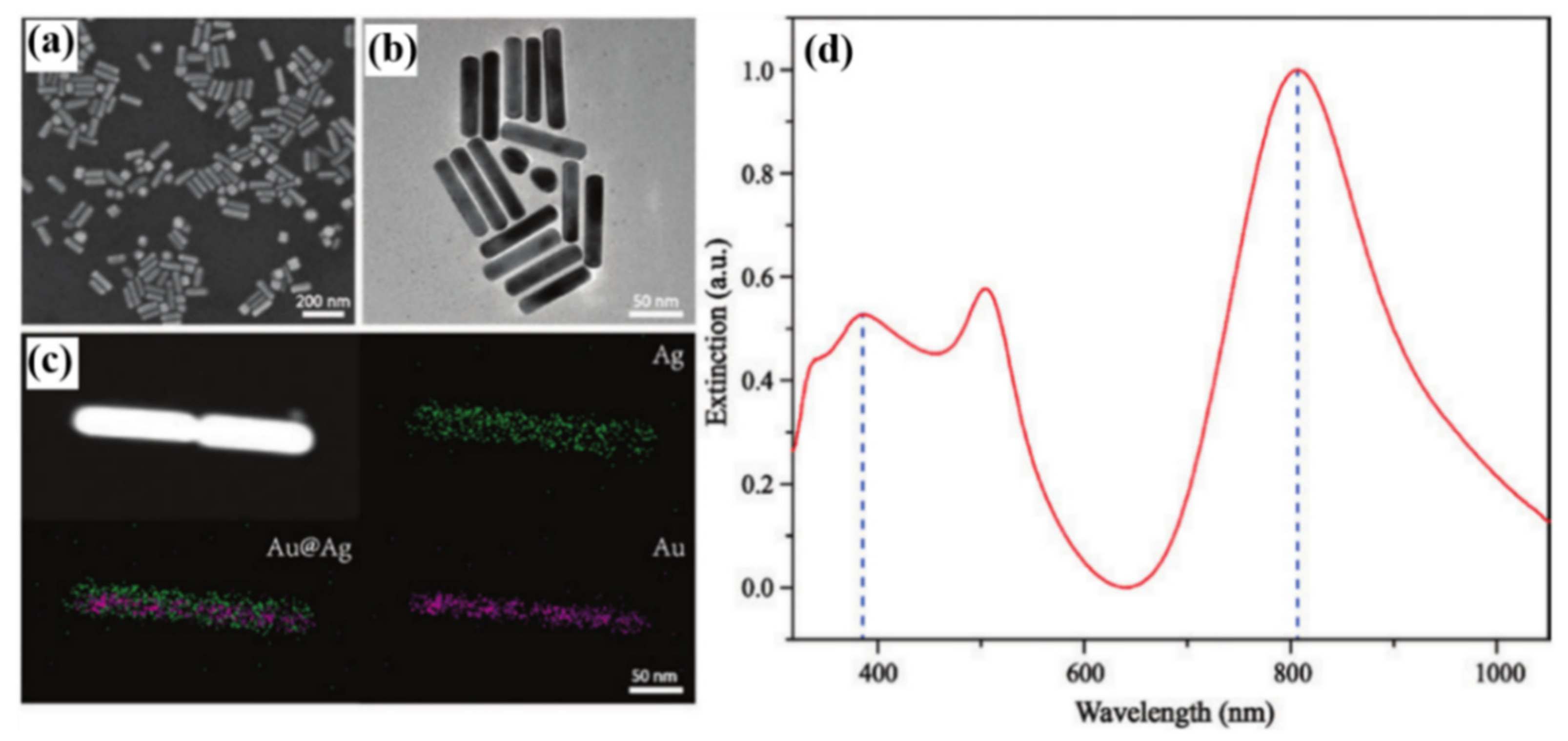

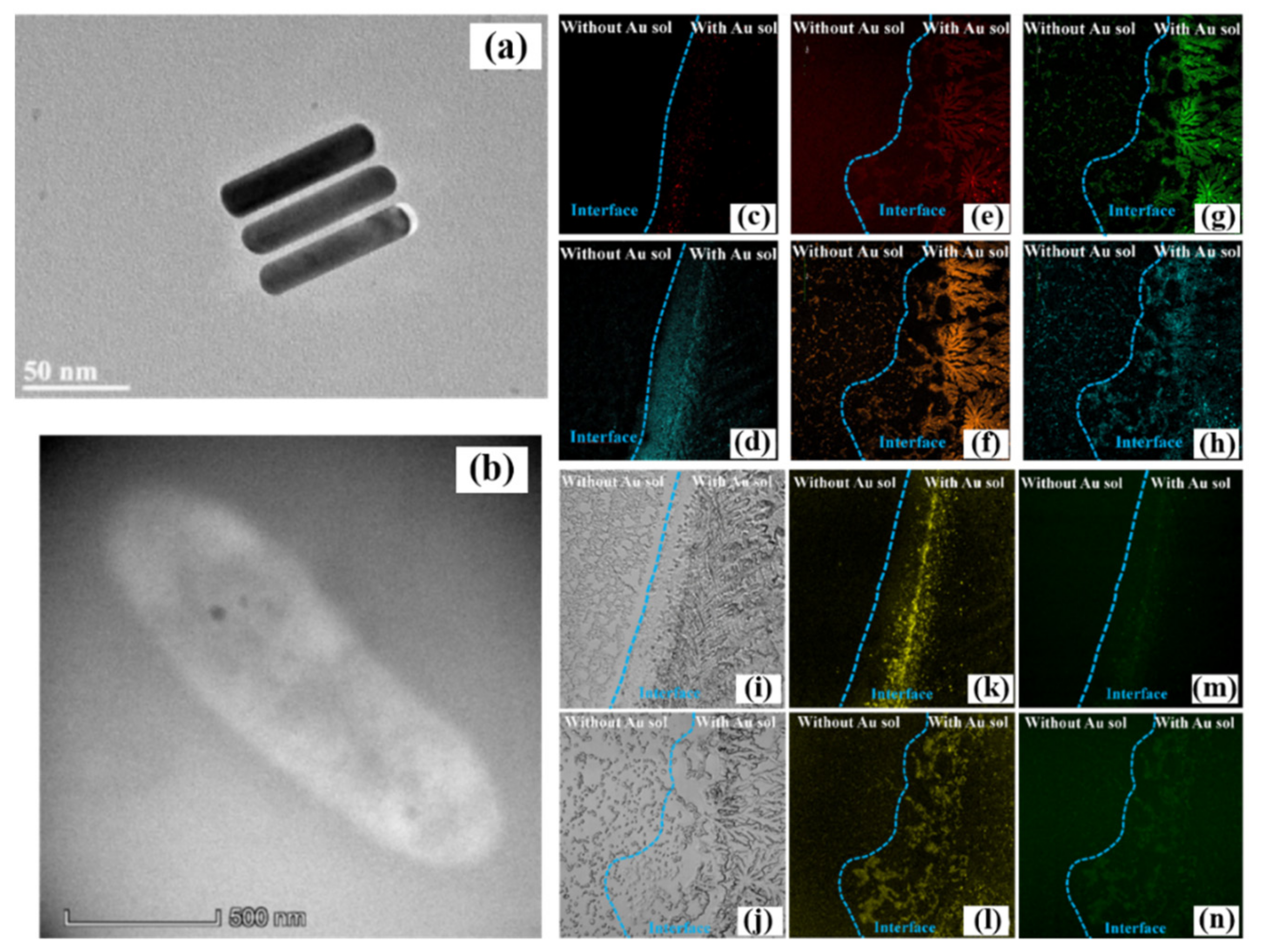
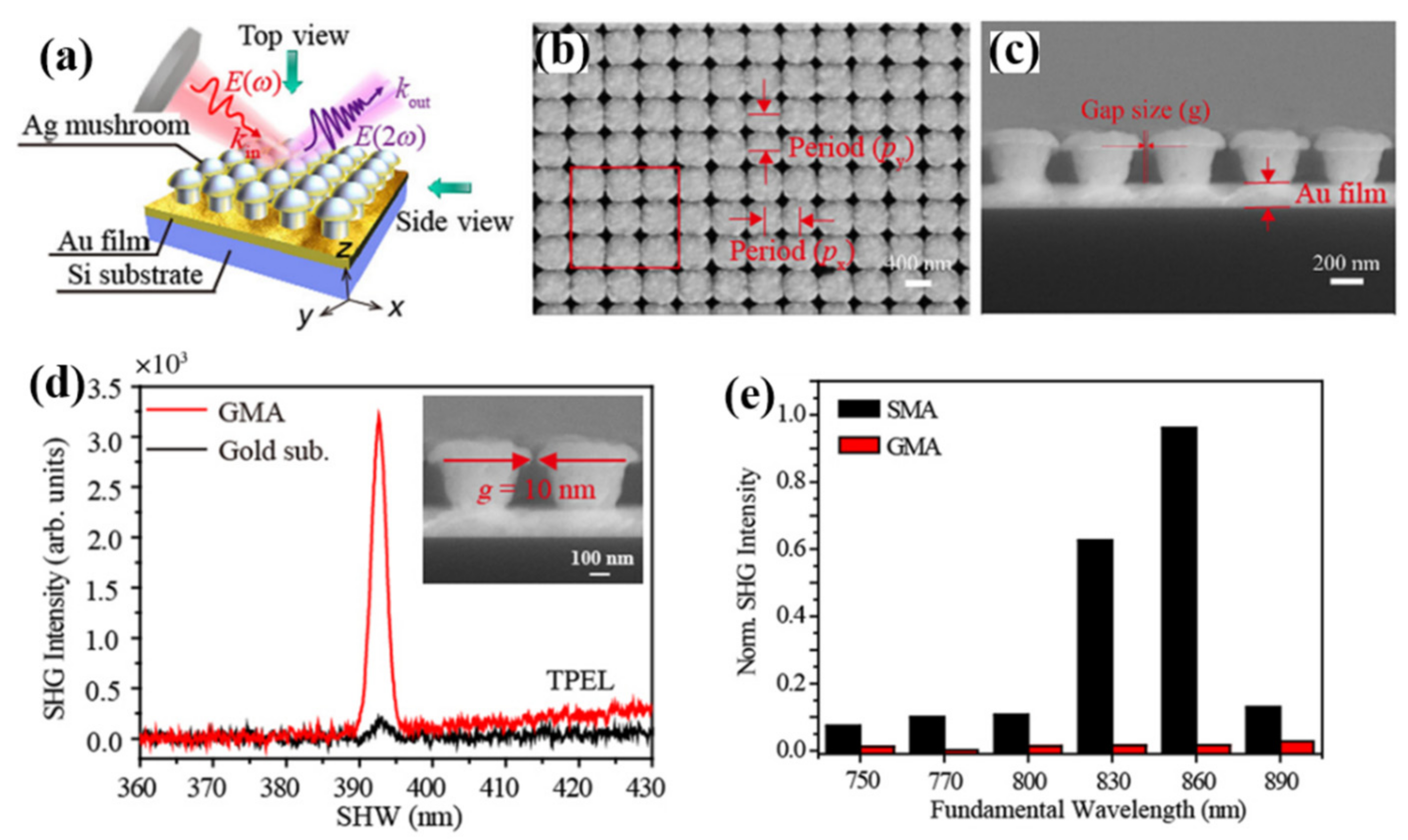


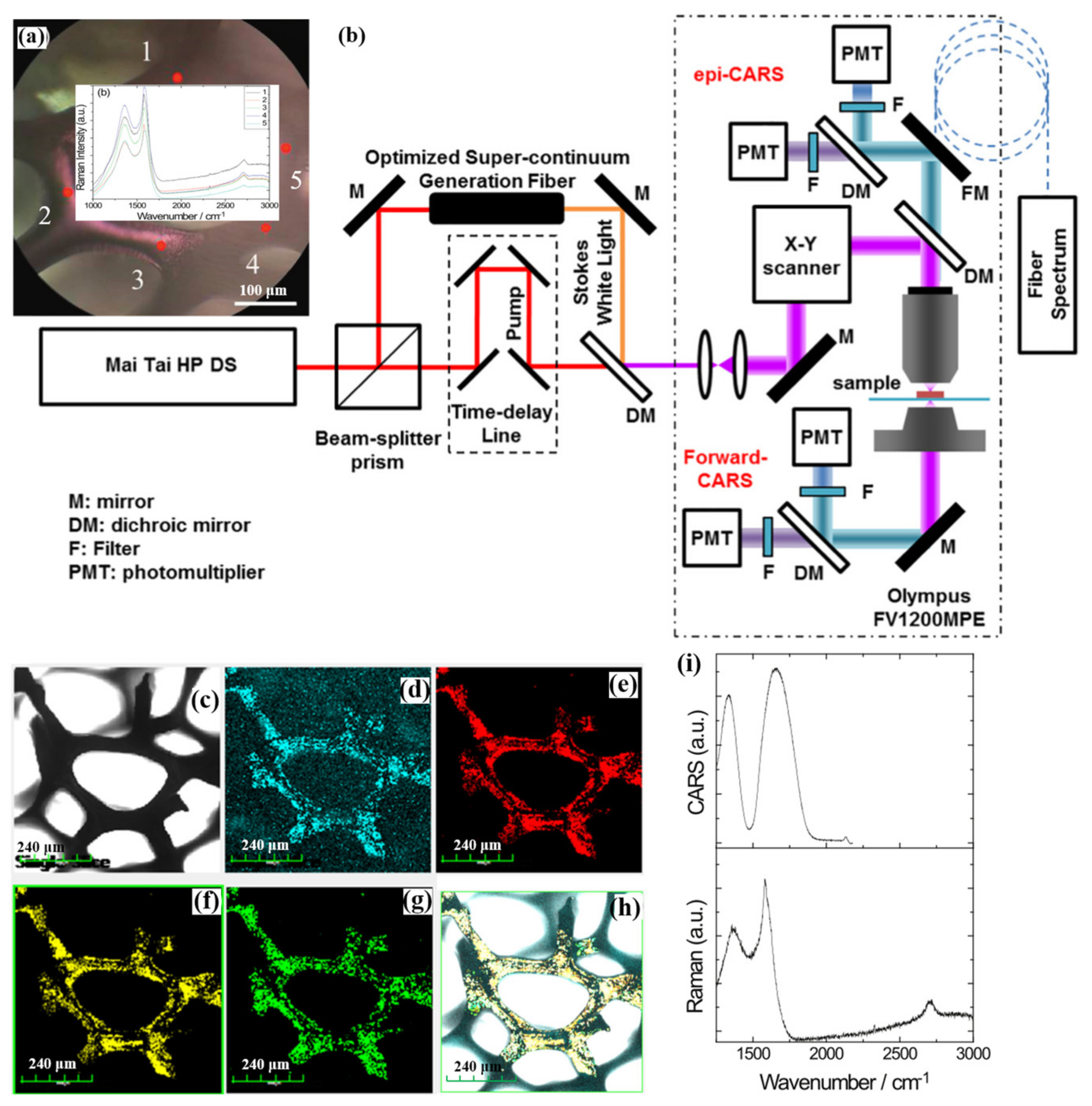

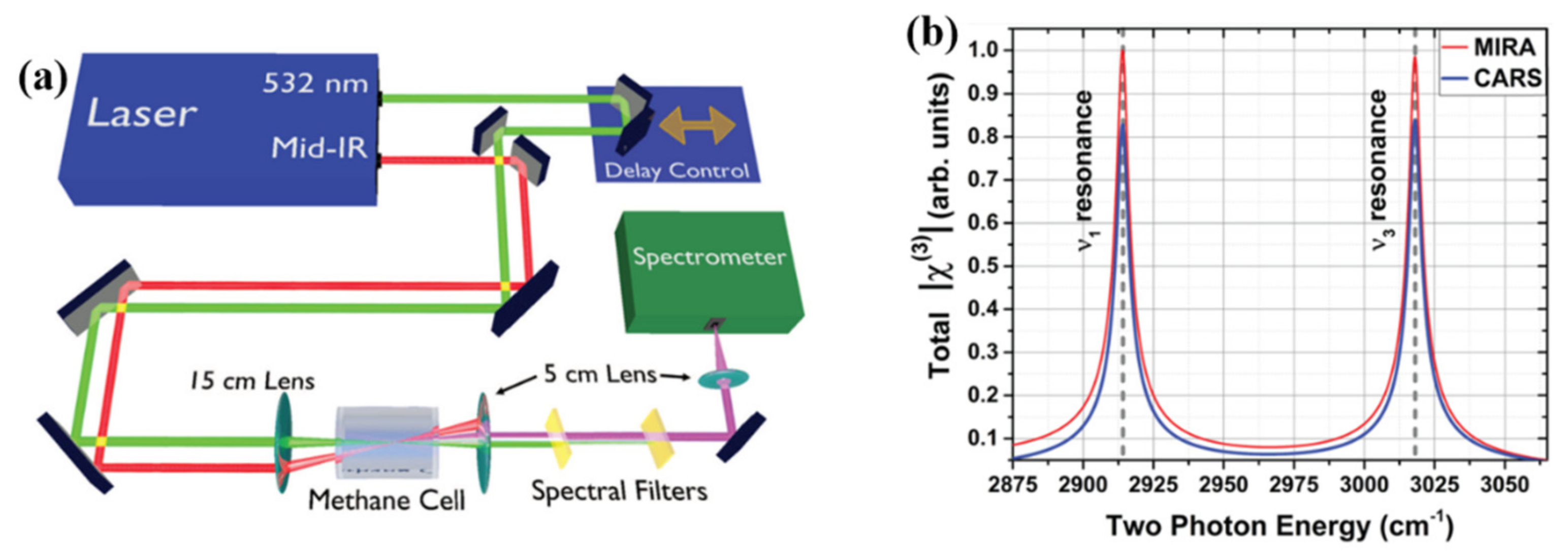


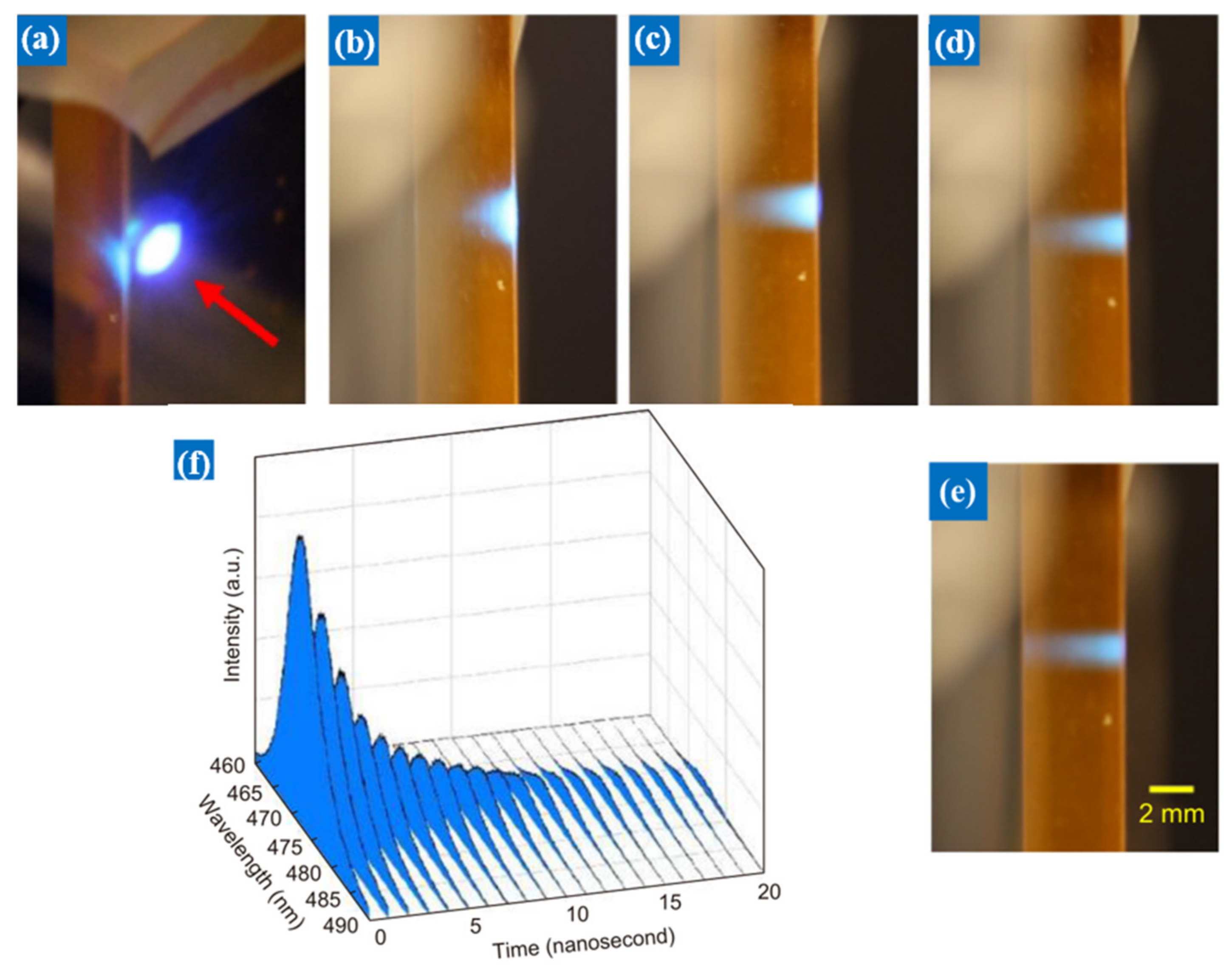
Publisher’s Note: MDPI stays neutral with regard to jurisdictional claims in published maps and institutional affiliations. |
© 2022 by the authors. Licensee MDPI, Basel, Switzerland. This article is an open access article distributed under the terms and conditions of the Creative Commons Attribution (CC BY) license (https://creativecommons.org/licenses/by/4.0/).
Share and Cite
Cao, Y.; Li, J.; Sun, M.; Liu, H.; Xia, L. Nonlinear Optical Microscopy and Plasmon Enhancement. Nanomaterials 2022, 12, 1273. https://doi.org/10.3390/nano12081273
Cao Y, Li J, Sun M, Liu H, Xia L. Nonlinear Optical Microscopy and Plasmon Enhancement. Nanomaterials. 2022; 12(8):1273. https://doi.org/10.3390/nano12081273
Chicago/Turabian StyleCao, Yi, Jing Li, Mengtao Sun, Haiyan Liu, and Lixin Xia. 2022. "Nonlinear Optical Microscopy and Plasmon Enhancement" Nanomaterials 12, no. 8: 1273. https://doi.org/10.3390/nano12081273
APA StyleCao, Y., Li, J., Sun, M., Liu, H., & Xia, L. (2022). Nonlinear Optical Microscopy and Plasmon Enhancement. Nanomaterials, 12(8), 1273. https://doi.org/10.3390/nano12081273





